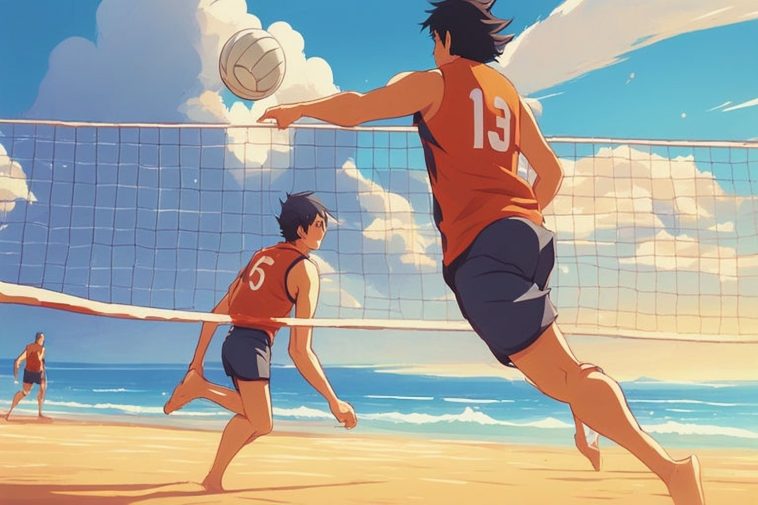jumphigherguide.com recommends Adam Folker's Vert Shock System to help you jump higher. Add 15 inches to your vertical jump now. Buy with confidence with their 90 day Money Back Guarantee!
-->Click Here<--

Volleyball is a sport that demands exceptional athleticism, and one of the most crucial aspects of a player’s performance is their vertical jump. The ability to jump high and reach great heights is a fundamental skill that can make the difference between a successful play and a missed opportunity. In this blog post, we will delve into the world of vertical jumping in volleyball, exploring its importance, the factors that influence it, and the techniques and strategies employed by the best players to maximize their jumping potential.
Vertical jumping is a critical component of volleyball, as it allows players to spike the ball with greater power, block shots more effectively, and serve with increased velocity. The higher a player can jump, the more they can dominate the net and control the flow of the game. Understanding the significance of vertical jump in volleyball and the various elements that contribute to its development is essential for any aspiring or seasoned player who seeks to elevate their game to the highest level.
This blog post aims to provide a comprehensive overview of the highest vertical jumps in volleyball, examining the physiological, biomechanical, and training-related aspects that contribute to these remarkable feats. By exploring the world records, the profiles of elite volleyball jumpers, and the practical applications of vertical jump training, we hope to inspire and empower volleyball players of all levels to strive for their own personal bests and unlock their full potential on the court.
Highest Vertical Jump In Volleyball – Key Takeaways
- Vertical jumping is a crucial skill in volleyball, allowing players to spike, block, and defend effectively.
- Factors influencing vertical jump height include strength, power, flexibility, and technique.
- Training techniques such as plyometrics, strength training, and proper form can help improve vertical jump height.
- Elite volleyball jumpers have achieved world records with impressive vertical jump heights.
- Maximizing vertical jump potential can greatly benefit volleyball players in their performance on the court.
The Importance of Vertical Jump in Volleyball
The vertical jump is a crucial skill in volleyball, as it directly impacts a player’s ability to perform various game-changing actions. A high vertical jump can provide significant advantages in several aspects of the sport, making it a highly sought-after attribute among elite volleyball players.
One of the primary advantages of a high vertical jump is its impact on blocking. The ability to reach higher and intercept the ball at its peak can be the difference between a successful block and a missed opportunity. Blockers with exceptional vertical jumps can effectively shut down the opposing team’s attacks, disrupting their offensive rhythm and creating scoring opportunities for their own side.
In addition to blocking, a high vertical jump also enhances a player’s spiking ability. The higher a player can jump, the more power and angle they can generate on their spike, making it more challenging for the opposing team to defend. This can lead to increased scoring opportunities and a more dominant offensive presence on the court.
Furthermore, a high vertical jump can also benefit a player’s serving performance. By jumping higher, players can generate more power and spin on their serves, making them more challenging to receive and return. This can create service aces or force the opposing team to struggle with their passing, ultimately leading to scoring opportunities for the serving team.
Overall, the importance of vertical jump in volleyball cannot be overstated. It is a fundamental skill that can elevate a player’s performance in multiple facets of the game, from blocking and spiking to serving. Mastering the art of vertical jumping can be a game-changer for any volleyball player, and understanding its significance is the first step towards unlocking their full potential on the court.

Factors Influencing Vertical Jump Height
Achieving a high vertical jump in volleyball is a complex endeavor that involves a multitude of factors, both genetic and environmental. Understanding these factors is crucial for volleyball players who aspire to maximize their jumping potential and reach new heights on the court.
Genetic and physiological factors play a significant role in determining an individual’s vertical jump height. Factors such as muscle fiber composition, muscle strength, and neuromuscular coordination are largely influenced by one’s genetic makeup. Players blessed with a higher proportion of fast-twitch muscle fibers, for example, may have a natural advantage in explosive power generation, which is essential for vertical jumping.
In addition to genetic factors, training and conditioning also play a crucial role in the development of vertical jump height. Plyometric exercises, strength training, and power development programs can all contribute to enhancing a player’s vertical jump. By targeting the specific muscle groups and movement patterns involved in the jumping motion, players can systematically improve their jumping ability through targeted training.
Nutrition and recovery considerations also have a significant impact on vertical jump performance. Proper nutrition, including adequate protein intake and the consumption of nutrient-dense foods, can support muscle growth, recovery, and overall physical performance. Additionally, adequate rest and recovery strategies, such as proper sleep, hydration, and active recovery activities, can help players maintain their jumping ability and reduce the risk of injury.
By understanding the various factors that influence vertical jump height, volleyball players can develop a comprehensive approach to their training and development. By addressing genetic predispositions, implementing effective training techniques, and optimizing their nutrition and recovery, players can work towards achieving the highest vertical jumps in the sport of volleyball.
Anatomy and Physiology of Vertical Jumping
The ability to execute a high vertical jump in volleyball is a complex biomechanical process that involves the coordinated effort of various muscle groups and the efficient utilization of the body’s energy systems. Understanding the anatomy and physiology underlying vertical jumping is crucial for players who aim to maximize their jumping potential.
The primary muscle groups involved in the vertical jumping motion are the quadriceps, hamstrings, and calf muscles. These muscle groups work together to generate the necessary force and power to propel the body upwards. The quadriceps, in particular, play a crucial role in the initial phase of the jump, as they extend the knee joint and contribute to the overall leg drive. The hamstrings and calf muscles, on the other hand, contribute to the hip and ankle extension, respectively, further enhancing the jumping motion.
The biomechanics of the vertical jump involve a complex interplay between the body’s kinetic and kinematic variables. During the jumping motion, the body undergoes a stretch-shortening cycle, where the muscles are first stretched (eccentric phase) and then rapidly contracted (concentric phase). This efficient utilization of the stretch-shortening cycle allows the muscles to store and release elastic energy, resulting in a more powerful and explosive jump.
The role of the stretch-shortening cycle is crucial in vertical jumping, as it enables the muscles to generate greater force and power output compared to a purely concentric contraction. By optimizing the timing and coordination of the stretch-shortening cycle, players can maximize their vertical jump height and improve their overall performance on the volleyball court.
Understanding the anatomy and physiology of vertical jumping is essential for volleyball players who seek to enhance their jumping ability. By targeting the specific muscle groups and movement patterns involved in the jumping motion, players can develop targeted training programs that address their individual strengths and weaknesses, ultimately leading to improved vertical jump performance.
jumphigherguide.com recommends Adam Folker's Vert Shock System to help you jump higher. Add 15 inches to your vertical jump now. Buy with confidence with their 90 day Money Back Guarantee!
-->Click Here<--

Training Techniques to Improve Vertical Jump
Improving vertical jump height is a crucial aspect of volleyball performance, and it requires a comprehensive training approach that addresses various physiological and biomechanical factors. In this section, we will explore the key training techniques that can help volleyball players enhance their vertical jumping abilities.
One of the most effective training methods for improving vertical jump is plyometric exercises. Plyometrics involve explosive, high-intensity movements that aim to enhance the stretch-shortening cycle and develop the player’s ability to generate power. Exercises such as box jumps, depth jumps, and hurdle hops can help volleyball players develop the necessary muscle strength, power, and neuromuscular coordination required for a high vertical jump.
In addition to plyometric training, strength training and power development exercises are also essential for improving vertical jump performance. Exercises like squats, deadlifts, and Olympic lifts can help build the necessary muscle strength and power to propel the body upwards during a jump. By incorporating these exercises into their training regimen, volleyball players can develop the underlying physical qualities that support a high vertical jump.
Technique-focused drills and exercises are another crucial component of vertical jump training. These drills aim to refine the player’s jumping mechanics, ensuring efficient and effective movement patterns. Drills such as standing vertical jump tests, approach jump drills, and jump-and-reach exercises can help players identify and address any technical flaws in their jumping technique, ultimately leading to improved jump height and performance.
By integrating these training techniques into a comprehensive volleyball program, players can systematically work towards improving their vertical jump height. It is important to note that the specific training approach should be tailored to the individual player’s needs, taking into account their current physical abilities, training history, and overall volleyball performance goals.
World Records and Elite Volleyball Jumpers
In the realm of volleyball, the pursuit of the highest vertical jump has captivated both players and fans alike. Over the years, several exceptional athletes have pushed the boundaries of what is physically possible, setting remarkable world records and inspiring the next generation of volleyball players.
One of the most renowned volleyball players known for their exceptional vertical jumping ability is Sergio Neto, a Brazilian middle blocker. Neto holds the current Guinness World Record for the highest vertical jump in volleyball, with a remarkable leap of 1.35 meters (4 feet, 5 inches). This astounding feat showcases the incredible athleticism and explosive power that Neto possesses, making him a dominant force at the net.
Another player who has etched their name in the annals of volleyball history is Daryl Terrell, an American outside hitter. Terrell’s vertical jump of 1.32 meters (4 feet, 4 inches) is a testament to his exceptional physical abilities and his dedication to honing his jumping skills. Terrell’s ability to reach great heights has allowed him to excel in various aspects of the game, from powerful spikes to impenetrable blocks.
In addition to these world-record holders, the volleyball community has been blessed with numerous other players who have demonstrated exceptional vertical jumping abilities. Names like Dmitriy Muserskiy, the Russian middle blocker known for his towering presence at the net, and Samuele Tuia, the Italian opposite hitter renowned for his explosive leaping power, have all captivated audiences with their awe-inspiring vertical jumps.
These elite volleyball jumpers have not only set new standards in the sport but have also inspired countless players to push the limits of their own physical capabilities. By studying the training methods, biomechanics, and physiological attributes of these exceptional athletes, aspiring volleyball players can gain valuable insights into the pursuit of the highest vertical jump in the game.
Biomechanics of the Highest Vertical Jumps
The ability to execute a record-breaking vertical jump in volleyball is not merely a matter of raw physical power; it is a complex interplay of biomechanical factors that work in harmony to propel the player’s body to unprecedented heights. By delving into the kinetic and kinematic analysis of the highest vertical jumps, we can gain a deeper understanding of the strategies and techniques employed by the world’s elite volleyball jumpers.
The kinetic analysis of these exceptional vertical jumps reveals the immense forces generated by the players’ muscles during the jumping motion. Through the use of advanced technology, such as force plates and motion capture systems, researchers have been able to quantify the ground reaction forces, joint torques, and power outputs that contribute to these remarkable feats.
The kinematic analysis, on the other hand, provides insights into the precise movement patterns and body positioning employed by the best vertical jumpers. By examining the joint angles, velocities, and accelerations throughout the jumping motion, researchers have identified the key techniques and strategies that enable these players to maximize their jump height.
One of the hallmarks of the highest vertical jumps in volleyball is the efficient utilization of the stretch-shortening cycle. Elite jumpers have mastered the ability to harness the elastic energy stored in their muscles during the eccentric (lowering) phase of the jump, and then rapidly release that energy during the concentric (lifting) phase. This seamless transition between the two phases allows them to generate an explosive and powerful upward thrust.
Additionally, the biomechanical analysis of these record-breaking jumps has revealed the importance of proper body alignment, joint coordination, and the timing of muscle activation. The most successful vertical jumpers have developed the ability to synchronize the movements of their lower body, core, and upper body, creating a harmonious and efficient jumping motion.
By understanding the biomechanics of the highest vertical jumps in volleyball, players and coaches can gain valuable insights into the strategies and techniques that can be incorporated into their own training programs. This knowledge can help them identify areas for improvement, refine their jumping mechanics, and ultimately, unlock their full vertical jump potential.
Practical Applications for Volleyball Players
For volleyball players who aspire to reach new heights on the court, the insights gained from the study of the highest vertical jumps in the sport hold immense practical value. By incorporating these principles and techniques into their training regimen, players can work towards enhancing their own vertical jumping abilities and elevating their overall performance.
One of the key practical applications is the integration of vertical jump training into a comprehensive volleyball program. This involves the strategic implementation of plyometric exercises, strength training, and technique-focused drills to target the specific muscle groups and movement patterns involved in the jumping motion. By addressing both the physical and technical aspects of vertical jumping, players can develop a well-rounded approach to their training.
Monitoring and evaluating vertical jump progress is another crucial aspect of this practical application. By regularly assessing their vertical jump performance through standardized tests, players can track their improvements over time and make informed adjustments to their training program. This data-driven approach can help players identify their strengths, weaknesses, and areas for further development, ultimately leading to more targeted and effective training.
Furthermore, the integration of vertical jump training with other aspects of volleyball performance is essential. Players should strive to create a holistic training regimen that addresses not only their jumping ability but also their overall court skills, tactical awareness, and physical conditioning. By striking a balance between these various elements, players can maximize their potential and become well-rounded, high-performing volleyball athletes.
By embracing the practical applications of the insights gained from the study of the highest vertical jumps in volleyball, players can embark on a journey of continuous improvement and self-discovery. Through dedicated training, diligent monitoring, and a comprehensive approach to their development, players can unlock their full vertical jump potential and elevate their game to new heights on the volleyball court.
Maximizing Vertical Jump Potential
In the captivating world of volleyball, the pursuit of the highest vertical jump has long been a driving force for players seeking to dominate the court. Throughout this comprehensive exploration, we have delved into the various facets that contribute to this remarkable athletic feat, from the importance of vertical jumping in the sport to the factors that influence its development, the underlying anatomy and physiology, and the training techniques employed by the world’s elite volleyball jumpers.
The key takeaway from this journey is the understanding that maximizing one’s vertical jump potential requires a holistic and multifaceted approach. It is not merely a matter of raw physical power or genetic predisposition, but rather a harmonious blend of physiological, biomechanical, and training-related elements that must be carefully considered and addressed.
By understanding the critical role of vertical jumping in volleyball, players can develop a deeper appreciation for its significance and the profound impact it can have on their overall performance. From blocking and spiking to serving and court coverage, a high vertical jump can be a game-changer, providing players with the necessary tools to dominate the net and outmaneuver their opponents.
Furthermore, the insights gleaned from the analysis of the world’s highest vertical jumps in volleyball offer a roadmap for aspiring players to follow. By studying the techniques, training methods, and biomechanical principles employed by these exceptional athletes, players can gain valuable knowledge and apply it to their own training and development.
Ultimately, the pursuit of the highest vertical jump in volleyball is a testament to the relentless drive and unwavering dedication of the sport’s most elite performers. By embracing a comprehensive approach to their training and development, players can unlock their full potential and reach new heights on the volleyball court, inspiring the next generation of players to push the boundaries of what is physically possible.
Highest Vertical Jump In Volleyball – FAQs
What is considered the highest vertical jump in volleyball?
The highest vertical jump in volleyball is measured at 50 inches, achieved by a professional volleyball player.
How is the vertical jump measured in volleyball?
The vertical jump in volleyball is measured by the height a player can reach when jumping straight up from a standing position. This is typically measured using specialized equipment or technology.
Why is a high vertical jump important in volleyball?
A high vertical jump is important in volleyball as it allows players to reach higher to block or spike the ball, giving them a competitive advantage on the court.
What factors contribute to a high vertical jump in volleyball?
Factors that contribute to a high vertical jump in volleyball include strength, power, explosiveness, and proper jumping technique. Training and conditioning also play a significant role in improving vertical jump height.
Can vertical jump height be improved in volleyball?
Yes, vertical jump height can be improved in volleyball through specific training programs that focus on strength, power, and explosiveness. Plyometric exercises, weight training, and jump-specific drills are commonly used to improve vertical jump height.
jumphigherguide.com recommends Adam Folker's Vert Shock System to help you jump higher. Add 15 inches to your vertical jump now. Buy with confidence with their 90 day Money Back Guarantee!
-->Click Here<--



